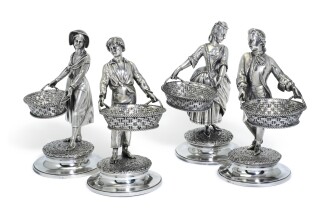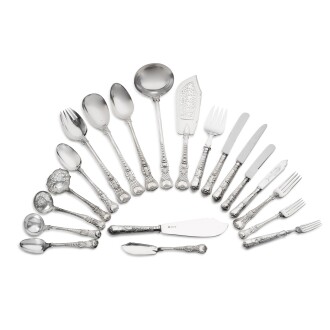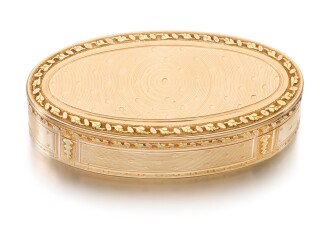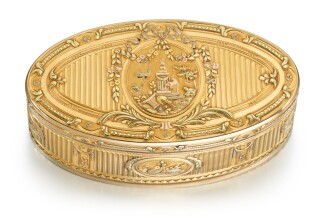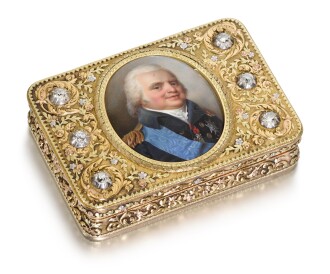T he sale of Gold Boxes, Ceramics & Silver taking place in London this May includes a beautifully curated selection of works of art spanning from the early 18th to the early 21st century. Colorfully enameled gold boxes mix with a bright array of Bohemian glass creating true candy store for collectors.
Sale Highlights
The Fascination of Hardstones
In his book, The Voyage of Italy (first published in Paris in 1670 and in London in 1685), the priest and travel writer Richard Lassels (1603?-1668), made a detailed study of the sights and treasures which compelled so many of his fellow countrymen to undertake the 'Grand Tour.' He had visited Italy five times and as 'Tutor to several of the English Nobility and Gentry' he was in an excellent position to make these observations. At one place in Florence he remarked upon a pietra dura ‘Table of polished stones of several colours and lustre, inlay'd into Birds and Flowers.'
Lassels was far from the first or alone to be dazzled by these 'polished stones of several colours’. From antiquity the beauty of hardstones has delighted collectors as much as they have challenged the artisan; converting nondescript rock or pebble into gleaming gem is an arduous process. Goldsmiths in France and Germany (see for example lot 32) were equally fascinated by hardstones. They carved, polished, cut or inlaid the minerals in many different ways, reflecting both scientific interest and aesthetic fascination. The latter also becomes obvious when looking at a collection of English hardstone gold boxes in the present sale. The caramel-coloured agates (lot 22), the mottled and patterned examples (lot 27 and lot 30), so carefully selected by 18th century English gold workers for their lustre, colour or inclusions resembling certain shapes, have their charm and unique fascination.
Like discovering familiar forms in passing clouds, some hardstones' naturally occurring swirls, ripples and stripes fool us into believing that we see here the head of a bird or there a rolling landscape. It's a trick of nature, of course, but no less beguiling for that and a concept much appreciated by 18th century connoisseurs, especially when combined with elaborate chasing or engraving of the gold surrounding the hardstones, such as lot 20 in this sale.
Property of a Private Scandinavian Collector
As part of this sale, Sotheby’s is proud to present a private Scandinavian collection of carefully assembled objects of vertu of high quality which reflect the collector’s fascination for 18th century Swedish craftmanship, featuring gold boxes and scent bottles by well-known, yet rare makers such as the court jeweller Frantz Bergs (lot 1) , Olof Ekman (lot 3) and Friedrich Fyrwald (lot 8) . Most of these gold boxes are illustrated in the relevant literature and have been included in major exhibitions. Not only does this group, however, contain some of the finest examples of Swedish gold work, but it also offers the opportunity to compare the fantastic gold chasing and elaborate enamelling that was done in Northern Europe in the 18th century Sweden to styles and techniques prevalent in other major centres of production at the time, such as Paris (see lot 5 or lot 11) , Geneva (lot 14) or Germany (lot 15) . The extraordinary and elegant black enamel box from Hanau (lot 12) successfully combines these two influences – the enamel plaque on the lid represents the Battle of Hogland, which was part of the Russo-Swedish war in 1788.


Three Bohemian pink-stained and engraved glass vases, late 19th century
2,000- 3,000 GBP
Bohemia has had a reputation for producing glass since the Medieval period and has been a center of excellence for wheel-engraving after Caspar Lehmann, the court gem-cutter to Emperor Rudolf II, adapted his skills to glass. It is equally admired for coloured glass and the 19th century saw a kaleidoscope of vivid colours become available to an eager international market. The technique of flashing glass, where clear glass is encased in a layer of brightly-coloured glass which allows the engraver to render elaborate scenes in a deeply engraved intaglio technique. Glass makers were interested in depicting their local topography and the forests and wildlife of the area. Stags and deer were particularly popular subjects and became the signature style for the region.

A Sarreguemines majolica water cistern and basin in the form of a turtle
5,000 - 7,000 – GBP
Wall-mounted cisterns were made across Europe and for the European market in China throughout the 18th century. The bright palette and durability of faience allowed potters to realised imaginative and playful designs. Cisterns had a practical application for handwashing; the last course of a grand meal would include fruits and sugared treats which guests would pick by hand from a buffet which would be arranged with elaborate ceramics and silver wares and was often enjoyed on terraces and rooms away from the banqueting hall and in the garden. The forms used for this course were derived from nature and a decorative and eye-catching cistern would fit perfectly with this theme. With the perfection of "majolica" ware in France and England in the mid-19th century colourful pottery became a feature of the fashionable home and wares became even more inventive and exotic. The potteries began to produce wares for an expanding middle-class clientele. There was a demand for pottery for use and in architectural contexts fueling the creativity of manufacturers. Whilst handwashing at the table in the 18th century was associated with the elite, by the 19th century the health benefits of cleanliness was apparent to all and wares such as the present cistern became attractive as well as amusing practical additions to the home.

A Meissen "Onion" pattern blue and white part dinner service, circa 1900
6,000 - 10,000 - GBP
The "Onion" pattern or Zweibelmuster was produced at Meissen from the early 18th century and is derived from a Chinese export porcelain pattern. The original Chinese pattern featured peaches and pomegranates to the borders as symbols of longevity and fecundity. Over time the unfamiliar pomegranate morphed into a bulb or onion giving us the familiar name we have today. The bold and distinctive pattern could be produced using stencils making it ideal to produce large dinner and dessert services making the wares practical. The design could be embellished, as with the present service, with a gilded rim.
Elisabeth, Empress of Austria and Queen of Hungary
Elisabeth, Empress of Austria and Queen of Hungary (1837-1898) by marriage to Emperor Franz Joseph in 1854. Her marriage at the age of sixteen moved her from a care-free childhood in Bavaria to the more rigid and formal life of the Habsburg court. Whilst she struggled with the strict protocol of court life, she had two children, daughters within two years of her marriage and gave birth to a son, Rudolf, Crown Prince of Austria and another daughter, Archduchess Marie Valerie, in later years. Sadly, her first born, Archduchess Sophie died in infancy and Elisabeth, known as Sisi, struggled with fits of melancholy and depression. Known for her great beauty and physical fitness, Sisi became one of the most recognisable figures in European Royalty. She was beloved by the Hungarian people for whom she had a great affection, learning Magyar and spending much of her time at the Imperial residence at Gödöllő outside Budapest. Whilst her husband clearly adored her, these feelings were not reciprocated and the couple spent long periods apart with Elisabeth often traveling throughout the Mediterranean and North Africa as well as stays at Lake Geneva and Bad Ischl.

